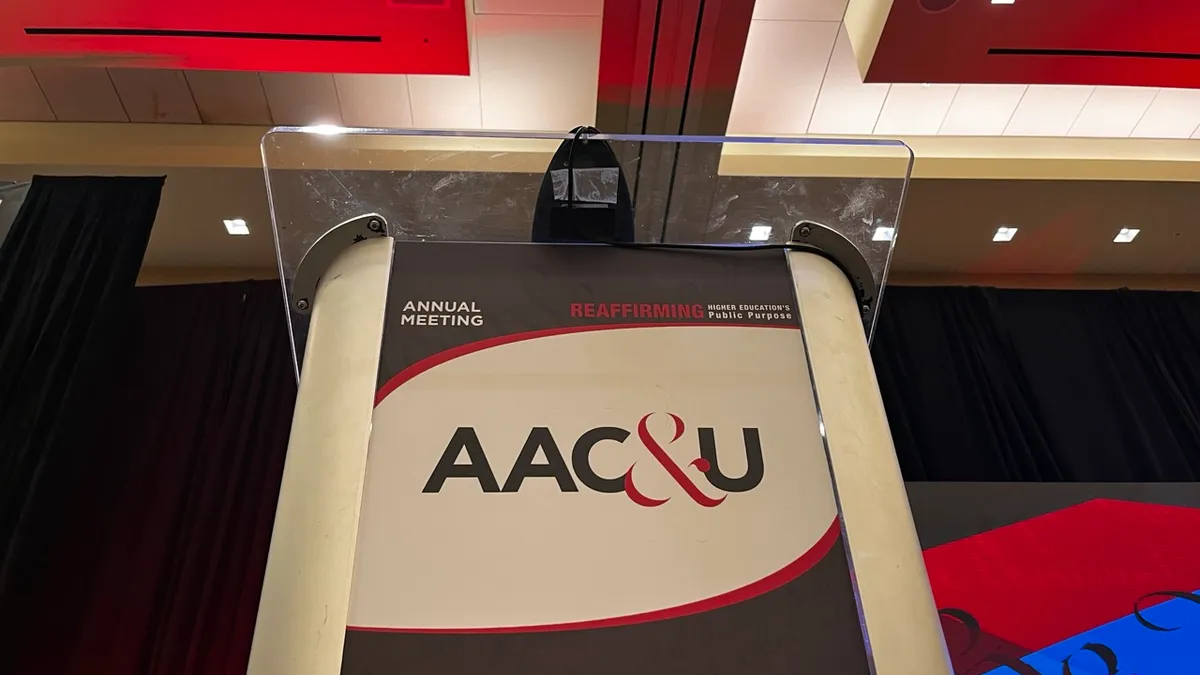A whopping one-third of higher education employees surveyed last year said they were likely to leave or consider leaving their college within the next two years, according to a poll conducted by the TIAA Institute.
Other polls have unearthed similar findings, suggesting that a sizable share of college employees may be heading for the exits. In TIAA Institute’s poll, 63% of workers said pay was their primary reason for considering leaving, 35% cited work-life balance and 34% pointed to career growth opportunities.
Panelists at the National Association of College and University Business Officers’ annual meeting this week discussed the employee retention challenges that colleges are facing and what strategies they can use to hold onto their talent.
It’s key for colleges to show what value they’re providing their employees, including the benefits they receive beyond their salary, said Shelly-Ann Eweka, senior director of research and strategic program initiatives at TIAA Institute, said during a panel Sunday. “We want to make sure that people understand through a holistic approach why they should value where they work.”
View compensation as an investment
For many colleges, employee compensation is the biggest line item in their budgets.
That can make it tempting to view compensation as a cost to manage, Mark Volpatti, CFO at Valparaiso University, said during the panel Sunday. But colleges need “to flip that mindset and say, ‘This is an investment,’” Volpatti said.
At Valparaiso, a Lutheran university in Indiana, officials baked compensation goals into the institution’s latest strategic plan, which calls for making salary and benefits more competitive for faculty and staff.
The university established a working committee to understand where salary gaps might exist across the institution. It found that some staff members who had the same position but worked in different areas of the university were paid differently.
In response, the university put some strategic funding aside for deans and vice presidents to allocate how they thought best, according to Volpatti.
“Some of it was to increase pay just because of pay equity,” Volpatti said. But officials also used it to keep a “superstar performer” they didn’t want to lose, he added.
Look at benefits beyond compensation
Colleges may struggle to meaningfully raise salaries, especially if they’re operating under heavy budget constraints. Queen King, interim vice president and CFO at California State University, Los Angeles noted during the panel Sunday that her own institution is seeing state funding cuts.
“And so trying to address salary and equity issues and being competitive is — from a CFO perspective — very taxing,” King said. “Because, No. 1, I do want to recruit people that fit into our culture, and also quality people as well, so that we can keep the mission of the university moving forward.”
King has looked at other job perks the university can offer, such as flexible work schedules.
For instance, some employees may not be able to start the day at 8 a.m. “But maybe they can come in at 9 a.m. and work from nine to six,” King said. “I'm just looking at more creative ways to provide flexibility for my team so that they can manage their work-life balance.”
In some cases, it may also be necessary to restructure or combine departments in order to boost salaries and hang onto employees.
“Some of those departments have been structured in that manner for the last 15, 20 years,” King said. “Maybe it doesn’t need to operate in that manner.”
Offer development and advancement opportunities
Compensation is a key issue at college campuses — just 31% of higher education employees said they were paid fairly in a 2023 survey conducted by College and University Professional Association for Human Resources.
However, similarly low shares of workers reported adequate training and advancement opportunities. For instance, around 39% of employees polled by CUPA-HR said their institutions invested in their development, and just 31% said they had advancement opportunities.
But it can pay off for colleges to invest in their own workforce, suggested Ann Forman Lippens, a managing director at education consultancy EAB, during a separate panel on Monday. “At a moment when the talent marketplace is quite competitive, it’s not necessarily always feeling like the right bet to look externally,” she said.
She noted that voluntary turnover rates are higher for external candidates than internal hires. Moreover, the search process can be expensive and take longer.
“There’s a pretty compelling business case to be made around investing in our existing staff and helping them grow their careers at our organizations,” she said.
One solution EAB recommends is a talent review process, in which staff have a one-hour conversation with their managers about their goals and create a roadmap for their future growth. Brynna Morgan, associate director at EAB, noted during the Monday panel that this is separate from a performance review.
“It really focuses on development and focuses on future advancement, and is not a look at past performance,” Morgan said.
But managers don’t have to be the only ones helping employees with their career growth. The University of Wisconsin-Madison, for instance, created two career coach positions to provide confidential counseling for employees.
These coaches assist employees with finding open positions on the campus, Patrick Sheehan, the university’s associate vice chancellor and chief human resources officer, said during the Monday panel. They also help employees develop their resumes and cover letters, conduct mock interviews and plot out their career plans.
The service has seen strong employee demand — over 750 appointments were conducted with workers in the fiscal year 2023, according to Sheehan.
Moreover, the university’s employee retention has improved recently, Sheehan noted.
“It’s hard to determine whether this is actually what’s causing that or when there’s other factors,” Sheehan said. “But certainly, I think this is playing a part in our employee retention that we’re seeing right now.”






















